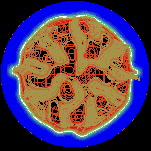



These images show the evolution of buoyancy driven convection in a rotating hemispherical shell. The simulation models the Geophysical Fluid Flow Cell (GFFC) which was run in micro-gravity experiments in 1985 and 1995 (see Hart et. al. 1986 (J. Fluid Mech. 173 pp. 519-544)). The experiment simulated radial gravity by imposing a strong electric field between the inner and outer spherical shells. The shell surfaces are held at constant temperatures, with the inner shell hotter than the outer, giving rise to buoyant forces in the fluid.
The visualizations shown here were computed in a frame of reference
which is rotating with the hemispherical shells, giving rise to
Coriolis forces which tend to drive rising plumes at the equator
in a clockwise direction.
At the poles, the rotation is in the opposite direction.
This simulation is at a Rayleigh and Taylor number of 5404 and 10000,
respectively, and was computed using 1536 spectral elements of order 4.
Higher resolution simulations of order 15 sustain 50 GFLOPS
on the Cray T3E, and will be used to study higher heating and
rotation rates as well as latitudinal variation in heating.
The electrostatic field used in the GFFC experiment gives rise
to a r-5 force law, as opposed to the
r-2 force law encountered in atmospheric
conditions. The numerical simulations will allow us to
study the effects of the force laws and the effects of
the solid equitorial boundary.
Additional spherical convection images.
More information on spherical convection.
Last update: November 4, 1998 (pff)